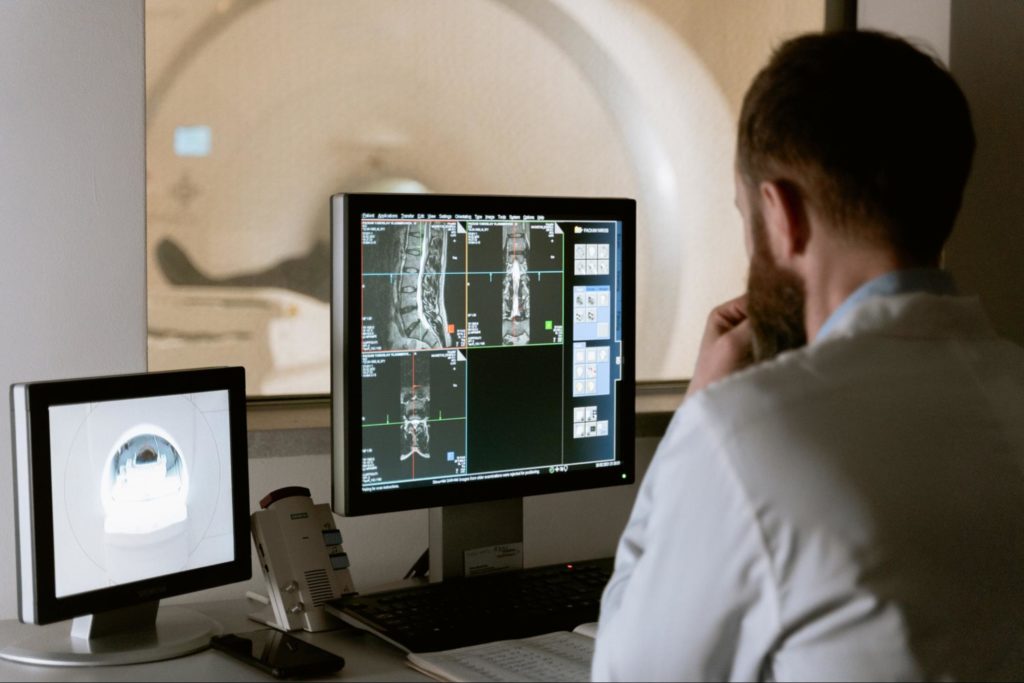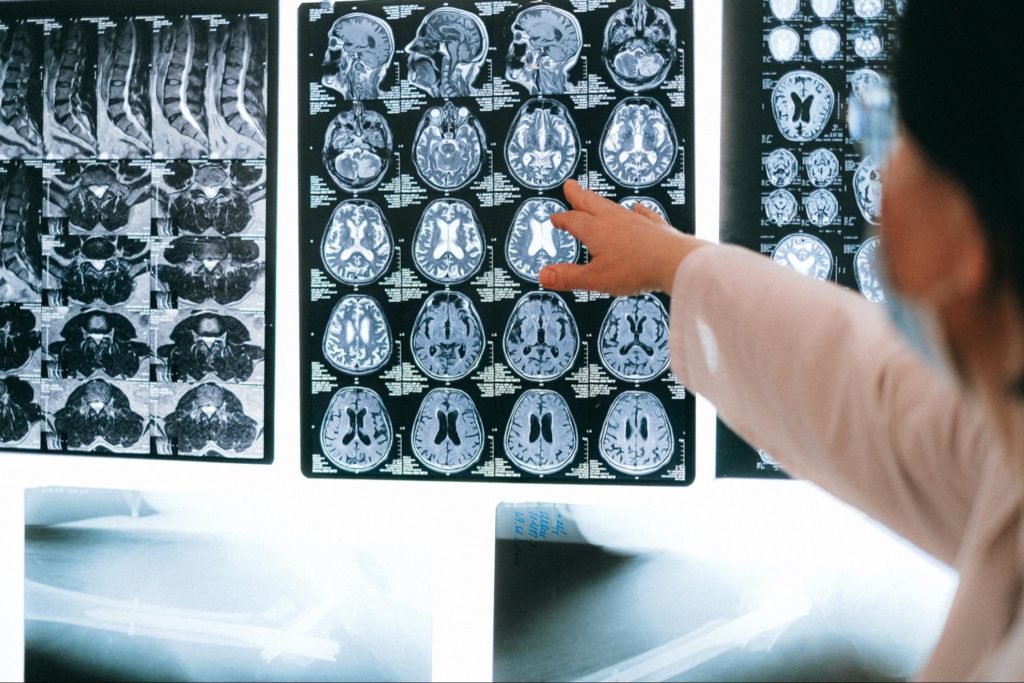
Artificial Intelligence (AI) in the global Healthcare Market size exceeded $ 4.2 billion in 2020 and is expected to grow by 33.7% CAGR between 2021 and 2027, reaching $ 34.5 billion by the end of the period. According to Gartner’s Hype Cycle for Healthcare Providers, the technology is at the peak of inflationary expectations.
Healthcare is one of the most promising industries in terms of the implementation and application of biometrics and AI technologies. Ensuring the implementation of AI-driven video analytics in medical organizations will allow for early diagnosis, reducing the risk of developing diseases. In addition, Clinical Decision Support System (СDSS) can help analyze medical images, optimize an individual treatment plan, and predict patient conditions based on available data, and beyond.
NtechLab has interviewed healthcare experts and identified numerous potential benefits to the medical community by providing AI-enabled medical imaging solutions in the healthcare industry.
This article will look at the current challenges hindering the broader adoption of AI in medical imaging, the benefits of such technology, and cutting-edge opportunities.
Signify Research estimates the global market of AI in Medical Imaging at $ 0.3 billion, which is anticipated to reach $ 1.15 billion by 2025 at a 25.6% CAGR.
Progressive developers have started to implement innovative automation such as computer vision for СDSS within various laboratory diagnostics. Medical imaging solutions are bound to establish an essential niche, but there are some obstacles standing in the way of finding broader acceptance in healthcare facilities:
Decentralized Storage
Medical institutions usually store patient data on their local systems. The problem is that there is no centralized storage for the entire medical history of all patients. By analyzing big data individually and in combination, we can improve and control the quality of diagnostics and predict the course of diseases.
GDPR Compliance
Today, General Data Protection Regulations do not clearly explain the relationship between the developer and the medical personnel. The lack of transparent legal mechanisms delays the broader adoption of AI in medical imaging. Another technical issue is the time-consuming legalization of computer vision and AI-based solutions. The product must be registered and undergo various tests before being used in medical practice.
Difficulties in Organizing Expert Consensus
It takes more than one doctor to train neural networks while developing a CDSS (Clinical Decision Support System) solution. Five or more specialists must verify the results before making a solid conclusion to avoid misinterpretations and mistakes that can be critical.
Conservatism
The medical community’s reluctance to embrace a new product is normal. The only thing that can help overcome the issue is the increasing implementation of successful use cases confirming the effectiveness of innovative solutions.
Overall diagnostic error rates in real-world practice are unknown, but a commonly cited estimate based on expert opinion is that 10−15% of all rendered diagnoses are incorrect.

Applying AI in Medical Imaging
Pre-Medical Diagnostics
Mobile applications for quick medical self-checkup, sleep, and health trackers help maintain a healthy lifestyle and spot both slight and significant deviations from the norm without having to pay a visit to a doctor.
Diagnostics
CDSS can help improve the quality of diagnostics by automatically highlighting areas of pathology and calculating parameters to determine a diagnosis. In a perfect case scenario, algorithms will be able to create a pre-filled medical opinion using a variety of similar cases. In this case, the doctor will either approve or disapprove of the medical statement and thus save time.
Treatment
Doctors need to calculate the parameters for surgeries manually without special AI-based software. The software enables doctors to do it automatically, which allows them to avoid miscalculations and transfer the patient to the surgery department faster.
Healthcare facilities can leverage AI-based analytics for screenings, precision medicine, and risk assessment to help doctors look at the genetics, environment, and lifestyle of a person in order to select a treatment that could work best for them.
Monitoring
Monitoring nurses’ and doctors’ actions can help maintain patient bypass schedules. AI-driven video analytics can detect whether or not the patient was given the right medicine at the right time.
Prediction
Observing the patient in the post-rehabilitation period can help prevent the return of pathologies. Doctors can analyze big data in similar cases to detect relapse. Moreover, governments can predict and control the spread of viruses or the course of diseases.
Automated diagnostic quality audits both in medical institutions and at the level of state healthcare regulation will allow reviewing and analyzing medical case studies, identifying inaccuracies.
Automated diagnostics can also be applied to test subjects participating in clinical trials of new drugs to study their physical condition.

Who is to Benefit?
- Healthcare is one of the few areas where even the slightest mistake can be critical. Both healthy people and hospital patients can receive an accurate doctor’s diagnosis, prescriptions, and recommendations.
- Doctors are, first of all, people, and people can be distracted or tired. While everything depends on their decision, we need to develop more automated diagnostics solutions to help them identify conditions quicker, promoting early intervention.
- Researchers have to go through vast amounts of data daily when discovering new drugs, conducting genetic research, or clinical trials. With AI-driven technology in medical imaging, they can process even larger data sets, approve new-to-market medications faster, and drive advances in modern healthcare.
- Healthcare institutions can take advantage of computer vision technologies to manage operational processes. A few application examples would be monitoring staff activities or online check-in terminals.
- Governments can predict the spread of viruses and diseases by analyzing large amounts of data.
The AI market in medical imaging is evolving rapidly and is set to drive a significant change in the medical community. There are currently many ambitious projects, but only a few turn into actual use cases due to various reasons mentioned in this article.
Responsibility and morality issues primarily lie not in the plane of the product but the use of the product and its development. In other words, the developer must consider the diversification of data sets and avoid biased conclusions. The doctor has to make a decision with the help of technology, using it as a trusted second opinion. The product is not designed to replace the doctor, just to support the decision-making process.
The AI in the Medical Imaging market is a new and responsible business direction for NtechLab. Our company is open to cooperation proposals and encourages the scientific, medical, and business community to join our ambitions.
Contact Us
Sources:
1) Machine Learning in Medical Imaging. World Market Analysis 2021 (July / Signify Research) — www.gminsights.com/industry-analysis/healthcare-artificial-intelligence-market
2) «GMInsights 2020 & Market & Market Report 2020.»
3) «Hype Cycle for Healthcare Providers, Gartner, 2021.»
4) Newman-Toker, David, et al. «Rate of Diagnostic Errors and Serious Misdiagnosis-Related Harms for Major Vascular Events, Infections, and Cancers: Toward a National Incidence Estimate Using the ‘Big Three.'» De Gruyter, 1 Feb. 2021 — www.degruyter.com/document/doi/10.1515/dx-2019−0104/html
